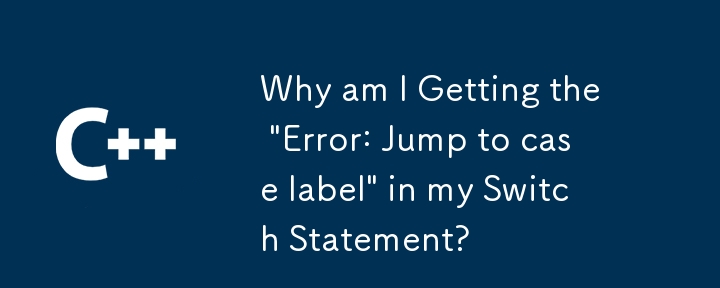

Diagnosing "Error: Jump to case label" in Switch Statements
When compiling a program that utilizes switch statements, users may encounter the error message, "Error: Jump to case label." This error typically arises due to misplaced variable declarations within switch case blocks.
Understanding Variable Scope in Switch Cases
Variables declared within a switch case block remain accessible in subsequent case blocks, even if not explicitly initialized. This behavior can lead to unexpected results if the variables are not properly initialized in their respective case blocks.
Example of Variable Scope Issue
Consider the following code snippet, which attempts to use a variable declared in one case block in a subsequent case block:
<code class="cpp">#include <iostream>
int main() {
int choice;
std::cin >> choice;
switch (choice) {
case 1:
int i = 0;
break;
case 2: // Error occurs here
}
}</code>In this code, the i variable is declared and initialized within the case 1 block. However, if choice equals 2, the compiler will attempt to access the i variable within the case 2 block, but it will not be initialized. This results in the "Jump to case label" error.
Solution: Use Block Scoping within Switch Cases
To resolve this issue, you should enclose each switch case block within an explicit curly brace block ({}). This confines the scope of any variables declared within a specific case block to that block, preventing access from subsequent case blocks.
<code class="cpp">#include <iostream>
int main() {
int choice;
std::cin >> choice;
switch (choice) {
case 1: {
int i = 0;
break;
}
case 2:
int j = 10;
break;
}
}</code>By using block scoping, you ensure that the i variable is only accessible and initialized within the case 1 block, and the j variable is only accessible and initialized within the case 2 block. This creates a proper and predictable variable scope within the switch statement.
By understanding the variable scope behavior in switch statements and using block scoping appropriately, you can avoid the "Jump to case label" error and ensure the correct initialization and usage of variables.
The above is the detailed content of Why am I Getting the \'Error: Jump to case label\' in my Switch Statement?. For more information, please follow other related articles on the PHP Chinese website!




